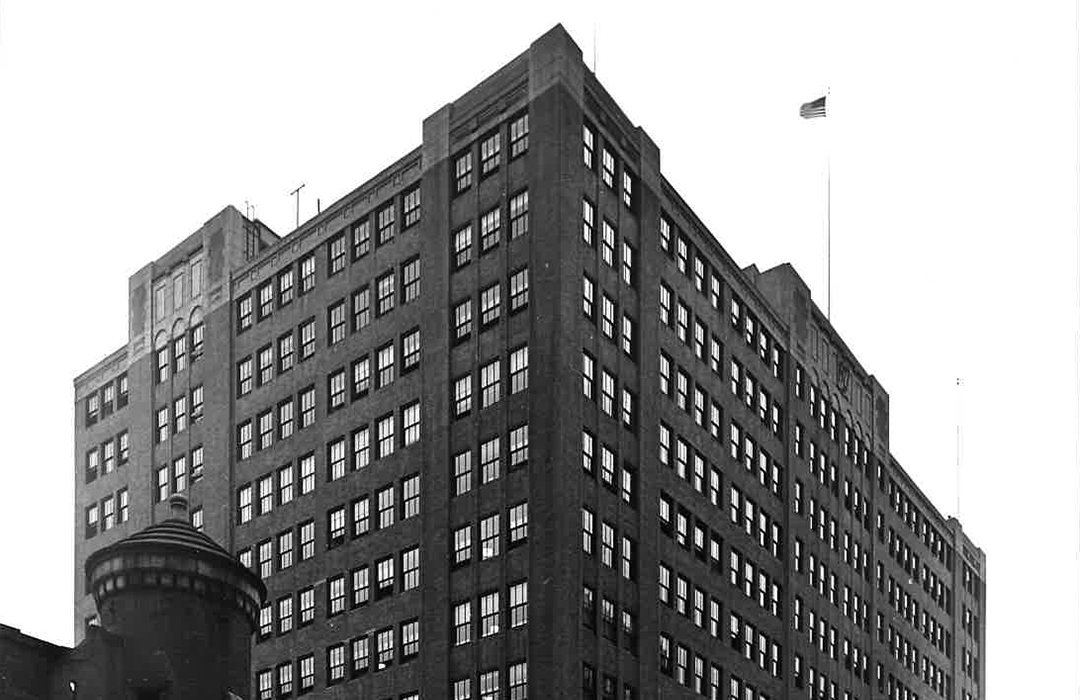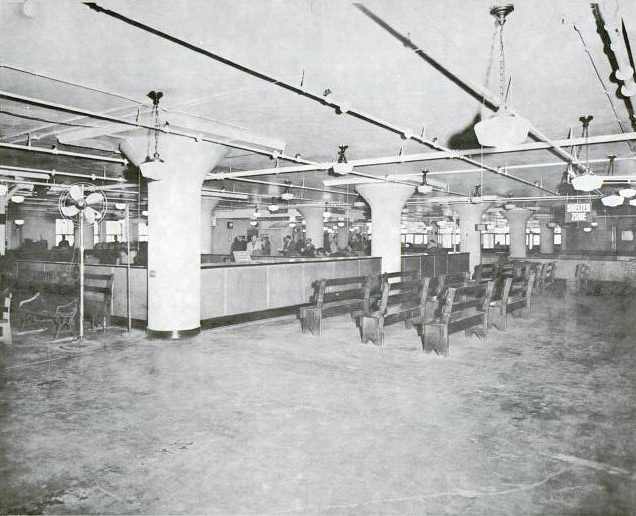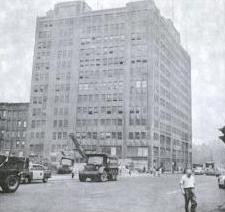
70 Columbus Avenue
by Sarah Bean Apmann
Built in 1927, 70 Columbus Avenue has had a number of occupants which lend to the overall story of San Juan Hill. It was originally built by and for an automobile company when this area was still part of Automobile Row. Later it housed a few federal agencies, including interestingly enough the Department of Justice Immigration and Naturalization Service (INS). And at the end of its existence, it would have a place in the story of the Lincoln Square Slum Clearance Project.
At the direction of Inglis M. Uppercu and designed by Charles. E. Birge, 70 Columbus Avenue was originally constructed as the auto hostelry for the Uppercu-Cadillac Motor Company. Previous to this, the company was occupying six separate offices in New York. The new 12-story structure allowed consolidation of the organization into one location and the building provided a centralized operation for the selling and servicing of the cars. During the early 1930s, the auto company had departed 70 Columbus Avenue and in 1936 the building became the home to the Works Progress Administration (WPA) which had previously been located at the Port Authority Building on Eighth Avenue.
By World War II, the building was occupied by the INS and the agency would reside here until the area was razed, sharing the space by the 1950s with the Atomic Energy Commission.
By World War II, the building was occupied by the INS and the agency would reside here until the area was razed, sharing the space by the 1950s with the Atomic Energy Commission.
As a brief history of the INS, in 1875 the Supreme Court ruled immigration a federal responsibility and as the number of immigrants coming to the US rose in the 1880s, Congress began to pass legislation to regulate it. With the passage of the Immigration Act of 1891, the Federal Government took on direct control of inspecting, admitting, rejecting, and processing all immigrants seeking to be admitted to the United States. That same legislation created the Office of the Superintendent of Immigration. At the beginning of the 20th century, the government sought to standardize naturalization procedures and enacted the Basic Naturalization Act of 1906. This act provided for the formation of the Federal Naturalization Service within the Bureau of Immigration expanding it to the Bureau of Immigration and Naturalization.
The New York Times reported in 1944 that a sales booth for war-bonds had been established in front of 70 Columbus Avenue, by then the home to the INS. The booth had been built there as “‘the last step in becoming a naturalized citizen in the southern district of New York.’” Newly-made American citizens were encouraged as they emerged from the court to make their first contributions as Americans by buying war bonds and stamps. Apparently, it was quite successful having sold $40,000 worth of bonds and stamps within its first four months of operation.
The Empire Hotel at 44 West 63rd Street has an interesting tie to the San Juan Hill area. It was at one point utilized by the INS to house deportees and in 1955, a daring escape was executed by an unnamed alien using bedsheets and draperies from the eleventh floor window of the hotel. As reported by The New York Times, the then district director of the New York INS, Edward Shaunnessy, explained that the “the man had escaped from a long prison term in the Western Hemisphere country.“ The New York Times went onto report that Mr. Shaughnessy anticipated better security in the INS’s new detention dormitory which has recently opened in the Federal Building at 641 Washington Street, the result of a $17,000 conversion effort. According to The New York Times, “the new quarters will lack the onus of the prison facilities that has been used temporarily for detained aliens until Dec. 17, following the Nov. 12 closing of Ellis Island.”
this property was owned by Robert F. Kennedy and three of his sisters, Jean Kennedy Smith, Eunice Kennedy Shriver, and Paricia Kennedy Lawford under a trust established by an intimate of Joseph Kennedy and Democratic moneyman, Charles Buckley.
In 1958, 70 Columbus Avenue and its remaining contents were included in an appraisal filed with the NY State Appellate Division as part of the “Lincoln Square Slum Clearance Project.” Referred to in the report as the “Kennedy Building,” its value was itemized as part of City’s Exhibit 185 and the appraisal was conducted by Henry Waltemade Realtors at 60 East 42nd street. While much of the land of the Lincoln Square Slum Clearance Project was acquired by the city through blanket condemnation, the city instead bought 70 Columbus Avenue for $2,500,000. This value of $62.88 per square foot was significantly different than adjacent properties worth $9.59 per square foot. What was the reason for the different approach for 70 Columbus Avenue? Well, it seems that this property was owned by Robert F. Kennedy and three of his sisters, Jean Kennedy Smith, Eunice Kennedy Shriver, and Paricia Kennedy Lawford under a trust established by an intimate of Joseph Kennedy and Democratic moneyman, Charles Buckley. This discrepancy was brought to the attention of the press and in the end, Moses was required to have a new appraisal done as a compromise. However, Moses used his own appraisers for the new appraisal and it was executed by the same men who made the original appraisals.
BIBLIOGRAPHY:
Caro, Robert A. The Power Broker, Robert Moses and the Fall of New York. NY; Random House, Inc. 1974.
“New Alien Detention Quarters Lack the Stigma of Prison Facilities.” The New York Times. January 5, 1955. P. 11.
“New U.S. Citizens Buy Bonds at Court Door.” The New York Times. June 19, 1944. P. 12.
“Uppercu Opens Auto Hostelry.” The New York Times. August 5, 1928. P. 12.
U.S. Citizenship and Immigration Services. “Overview of INS History, USCIS History Office and Library.” https://www.uscis.gov/sites/default/files/document/fact-sheets/INSHistory.pdf accessed 05/08/2022.
“U.S. to Resume Santo Quiz and Drop Court Tilt.” Daily News. October 11, 1947. P. 6.
“WPA Moves Entire Office Employing 3,000 to New Quarters Uptown During Week-end.” The New York Times. July 28, 1936. P. 17.
Sarah Bean Apmann is an architectural historian and principal of Sarah Bean Apmann Consulting, Inc.




